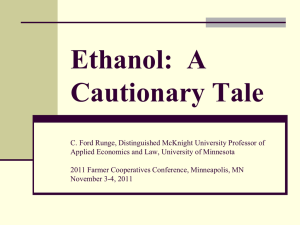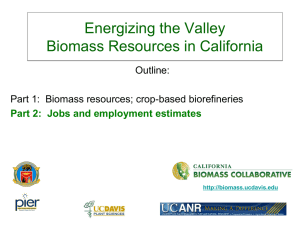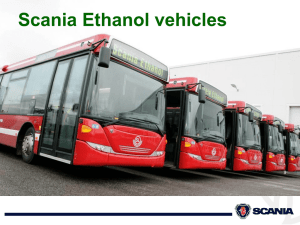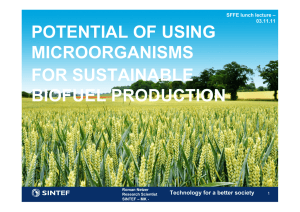Alternative Energy
advertisement
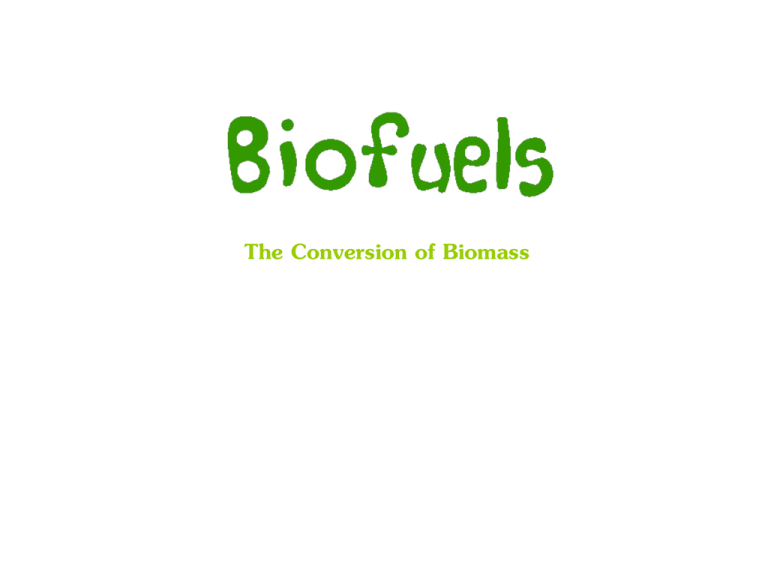
The Conversion of Biomass Biofuels Since the dawn of civilization humans have relied on plants for survival. Even today plants influence almost everything we do either directly or indirectly. They are the only source of food, fuels, shelter, clothes and medicines. Plants are the natural reservoir of chemical compounds and are designated as the best natural chemists. the term Biofuel covers solid biomass, liquid fuels biogases Plants as Sources of Petroleum Like Substances Gopher plant: grows wild in California: 25 barrels of crude oil per hectare Copaifera multijuga: found in Brazil: produces almost pure diesel fuel Jojoba: 50% oil by weight: resembles sperm whale oil: doesn’t go rancid The Energy Problem • How will society meet growing energy demands in a sustainable manner? • Fossil-fuels currently supply ~80% of world energy demand. Biofuels as an Alternative • Biofuels are not THE answer to sustainable energy, but biofuels may be part of the answer • Biofuels may offer advantages over fossil fuels, but the magnitude of these advantages depends on how a biofuel crop is grown and converted into a usable fuel Analysis of Alternative Biofuels First-generation' or conventional biofuels are biofuels made from sugar, starch, and vegetable oil. Second-generation biofuel implementation from non-food crops. These include waste biomass, the stalks of wheat, corn, wood, and special-energy-or-biomass crops (e.g. Miscanthus) Third generation biofuel is Algae fuel, also called oilgae, is a biofuel from algae Technology Progression Synthetic Biorefinery Gasification Direct Synthesis? Corn Algae Cellulosic Bioethanol 7 • • • • • Biogas Direct combustion Pyrolysis: Involves high temperatures (500900°C), low oxygen Main ingredient is methane. Can be produced by human, animal, and agricultural wastes. Biogas is isolated by the use of methane digesters. Ethanol/ Biodiesel Fuels • Fermentation • esterification • Ethanol can be produced by fermenting certain plants • Biodiesel is produced by using left over food products such as – Vegetable oil – Animal fats Biomass to Fuel Conversions Results: Alcohol (Ethanol) Biogas (Methane) Syngas Gasoline (Biocrude) Diesel Fuel (Plant Oil) • • • • Produced domestically, from renewable resources Ethanol is grain alcohol produced by corn and other crops Blended with gasoline to make fuels Ethanol blended gasoline is becoming more readily available and more cost efficient to consumer • The most common types of ethanol gas are: E10, which is 10% ethanol and 90% unleaded gasoline, appropriate for any make or model of any engine, and E85 which is 85% ethanol and 15% gasoline, must have flex-fuel engine to use… • Ethanol contains oxygen, so it burns cleaner and prevents gunky build up of automotive engines. Why Ethanol? Multiple Issues, One Answer – Cheaper fuel for consumers – More energy security & diversified sources – Higher farm incomes & rural employment – Significant carbon emission reduction – Faster GDP growth, Lower Imports & energy prices 11 Process of conversion to ethanol 1. 2. 3. 4. 5. Grind crops into fine powder, remainder is used to feed livestock powder is mixed with water and alpha-amylase, an enzyme that helps break the starch into smaller particles. The resulting mash is cooked at 120 to 150 degrees to liquefy the starch and reduce bacteria levels, and then heated to 225 degrees to help break the starch down further. mash is removed from the cookers and cooled. Then a second enzyme, glucoamylase, is added to help convert the liquid starch into a sugar that can be fermented. The mash is mixed with yeast, which changes the sugar to ethanol and carbon dioxide. It takes about 48 hours for the mash to ferment. Mixture is heated again to isolate ethanol, ethanol the condenses to its liquid form Saccharomyces cerevisiae • Well known microorganism: – Used for making wine, beer, bread etc. • Easy to use in the lab Bioreactor F Gin X: biomass G: glucose E: ethanol V: volume X G E V F: Glucose feed rate Gin: Inlet substrate concentration A simplified scheme for the processing of biomass into ethanol. Pilot plant for the anaerobic fermentation of biomass into mixed alcohol fuel by a mixture of microorganisms. Flex Fuel Vehicles (FFV) Little incremental cost to produce & low risk Consumer choice: use EITHER ethanol or gasoline Easy switchover for automobile manufacturers Fully compatible with Hybrid cars 17 Can Rapid Adoption of FFV Happen? Brazil: FFV Market Share of Light Vehicle Sales 4% in Mar’03 50% in May’05 70% in Dec’05 18 Energy Crops: Sugar Cane Sugar cane: very high productivity per acre. Use bagasse and sugar cane residues (sugar cane waste). Bagasse to energy plants: 7% of Hawaiian energy (Mauritius) Bagasse Energy Crops: Corn • ~ 2 billion gallons of corn ethanol produced in the U.S. annually. • Producing ethanol from corn requires almost as much energy to produce as it yields. • Corn is a major food crop— producing ethanol from corn reduces its availability for food and inflate prices. Benefits of Corn & Sugar Cane • • • • • Most Popular Improves wildlife habitat Reduced green house gases High sugar content Bagasse from sugarcane is also a good source of sugar Problems with Corn Sugar Cane • Less Efficient • producing corn ethanol requires about as much energy to produce as it yields • Since corn and sugar cane are major food crops, production of ethanol could decrease their amount of available for food & inflate prices • Grows very successfully • seems to be potentially more promising then corn, due to less waste… the whole plant is used to produce ethanol, not just a part. Needs very little energy to grow Benefits of Switchgrass • • • • • • • • • • • • Reduces soil erosion Improves wildlife habitat Can be co-produced for animal feed Durable Moisture efficient Low Maintenance High Yield High energy conversion & Efficiency Can grow in harsher areas Decreases wind flow Less water; less fertilizer; less pesticide Reduced green house gases Problems with Switchgrass • Requires a large energy input to process into ethanol • Requires a huge increase in industrialized farming • Could provoke farmers to grow switchgrass instead of other crops Energy Crops: Miscanthus 1 years growth without replanting! 10-30 tons/acre 26 Algae are photosynthetic organisms CO2 + H2O + Light Energy Biomass Algae very diverse: microscopic to giant kelp Efficient, rapid growth, can double biomass in a day Produce 50% of oxygen but are less than 1% of all plant biomass Few species have been studied for biofuel potential Chlorophyceae Dinophyceae Bacillariophyceae 27 ALGAE BIOFUEL –SUBSTITUE FOR FOOD RELIANCE CROPS; REDUCED GLOBAL WARMING & LOWERED ENVIRONMENTAL IMPACTS • Algae requires CO2 for growth therefore fuel is carbon neutral • Possible integration to achieve low-cost CO2 sequestration and nutrient remediation • Uses all nutrients, minimizing eutrophication • Biodegradable, so minimal issues with accidental spills /leaks • Uses underutilized land, e.g. deserts • Yields >10x those for land plants so much less land is needed • Can grow in salt, or brackish water • Can produce high yields of – Lipids for biodiesel – starch / polysaccharides for ethanol 28 Advantages of Ethanol Blends: Emissions •E85 •Low Evaporative emissions (Lower RVP) •Expected Low Permeation emissions in FFV’s •Low Nox in modern vehicles with oxygen sensors •Zero sulphur, low carbon monoxide, particulate & toxic emissions •E6 (low ethanol blends) •Low Nox in modern vehicles with oxygen sensors (higher in older vehicles) •Increased RVP and increased VOC’s (and hence ozone formation) •Increased permeation emissions in older vehicles •Reduced CO emissions …but •Reduced permeation emissions ( thicker hoses & plastics) in newer vehicles •California Low Emissions Vehicle II program reduces permeation and 29 evaporative emissions (part of 2007 Federal Law) Technology Improvements • Bioengineering • Enzymes • Plant engineering • Process & Process Yields • • • • • Process Cost Pre-treatment Co-production of chemicals Process Yield gals/ ton Consolidated bioprocessing • Energy crops • • • • Miscanthus Switch grass Poplar Willow • Recent trends • Synthetic Biology • Nanotechnology • Thermochemical 30 Biodiesel Biodiesel is an ecofriendly clean alternative diesel fuel produced from the plant sources. Large numbers of plants synthesize oils in their seeds. They may be edible or non-edible type. These natural oils when processed chemically (Reacted with alcohols to produce esters) show striking similarities to petroleum derived diesel and are called biodiesel. Biodiesel is an ecofriendly biodegradable, clean alternative renewable, low cost, nontoxic fuel produced from the plant Jatropha curcas. It contains more oxygen, no petroleum, essentially free of sulphur & aromatics, cleaner burn at higher temperature and will reduce green house gas emission. It can be used directly or blended with petroleum diesel to run the machinery. Why non edible oils instead of easily available edible oils are used for this purpose? deficiency in edible oil production and plants producing non edible oil may be the only material of choice for production of biodiesel. Azadirachta (Neem) Calophyllum (Undi) Pongamia (Karanj) Jatropha curcas (Bharenda) Of the above Jatropha curcas is considered most potential source as nonedible biodiesel producing plant in our country because it can be grown on almost any soil type found in our country Biofuel Plant Jatropha curcas Four Year Old Eucalyptus: Hawaii Eucalyptus: produce high amounts Of biomass under drier conditions Than hemp. Very hardy species. Lignin and biofuel production • Lignin has negative impacts on biofuel prodution – lignin impedes access of hydrolytic enzymes to wall polysaccharides – lignin adsorbs hydrolytic enzymes – lignin interferes with pretreatment processes – lignin degradation products inhibit fermentation – lignin is not fermentable (but its energy can be utilized) • Lignin is essential for plant viability; all the genes ar known • Can reducing lignin content, composition, and tissue specificity improve biomass quality? Plants seem to tolerate substantial lignin modification. Lignin modification may decrease the need for pretreatment How can biotechnology help with biofuel production? Changing the plant: greater yield (photosynthesis) domestication of partially domesticated plants (e.g. architecture, making plants more easily harvested) Changing the biomass components for easier processing: ratio of cellulose to lignin; structure of lignin; structure of cellulose; incorporating cellulase; new triglycerides that yield better biodiesel. Selecting new microorganisms (Synthetic genomics): efficiency of pentose fermentation; combining cellulose hydrolysis and fermentation; new fermentation end-products insoluble in water. Producing better enzymes: gene shuffling technologies Are Biofuels Cost Competitive? • In 2005, neither biofuel was cost-competitive with petroleum – but as petroleum prices increased the gap closed • Ethanol: – Estimated ethanol production cost in 2005 was $0.46 per gasoline energy equivalent L – Wholesale gasoline prices averaged $0.44/L in 2005 • Soy biodiesel – Estimated soybean biodiesel production cost in 2005 was $0.55 per diesel EEL, – Diesel wholesale prices averaged $0.46/L in 2005 • Recent price effects unfavorable for biofuels: – Lower fossil-fuel prices – Higher corn prices Advantages of Biofuels – Reduce our dependence on imported energy – Decrease carbon dioxide emissions – Strengthen farm economy & create new jobs Positive Environmental effects of ethanol and biodiesel Greenhouse gasses reduced by both relative to gasoline and diesel combustion Adverse Environmental effects • Fertilizer use • Pesticide application Toward better biofuels: 1) Biomass feedstock producible with low inputs (e.g., fuel, fertilizers, and pesticides) 2) Producible on land with low agricultural value 3) Conversion of feedstock into biofuels should require low net energy inputs Ultimately, the world will obtain most of its food, fuel, fiber, chemical feedstocks, and some of its pharmaceuticals from genetically altered vegetation and trees."



